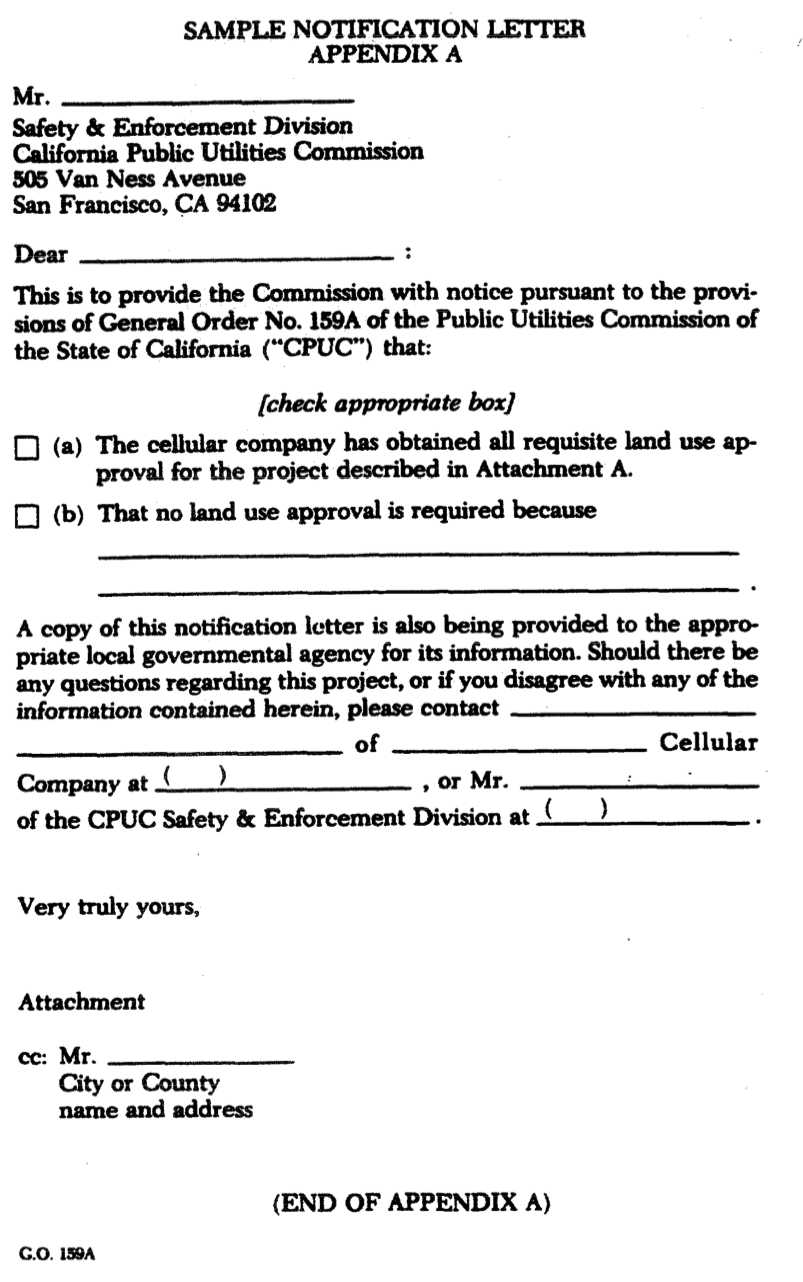PUBLIC UTILITIES COMMISSION OF THE STATE OF CALIFORNIA (link)
General Order 159: Rules relating to the construction of
Commercial Mobile Radio Service Facilities in California.
Adopted May 8, 1996, Effective May 8, 1996
by Decision 96-05-035, R.90=01-12
SECTION I — GENERAL
Pursuant to the provisions of sections 451, 701, 762, 761, 762, 762.5, and 1001 of the Public Utilities Code:

IT IS HEREBY ORDERED that except as specifically provided herein, no cellular service provider, now subject, or which hereafter may become subject, to the jurisdiction of this Commission, shall begin construction in this state of any cell site or Mobile Telephone Switching Office (“MTSO”) without first having obtained all requisite land use approvals required by the relevant local government agency. A cellular service provider shall provide a notification letter to the Commission that it has obtained the requisite land use approval(s) or that no such approval is required. Finally, to ensure that the Commission maintains adequate information regarding the location of cell sites and MTSOs, cellular service providers shall update this Commission on a quarterly basis with a tariff list of its facilities.
The Table of Contents and rules are set forth below.
| Page | Contents |
|---|---|
| 1 | I. GENERAL |
| 3 | II. PURPOSE |
| 4 | III. DEFINITIONS |
| 4 | IV. NOTIFICATION LETIER |
| 4 | A. Generally |
| 5 | B. Contents |
| 5 | C. Service By Mail |
| 6 | D. Exemptions |
| 6 | (1) Minor Maintenance and Repair Work |
| 6 | (2) Emergency Construction |
| 7 | V. QUARTERLY UPDATES |
| 7 | VI. COMPLAINT PROCEDURE |
| 7 | VII. APPLICATIONS FOR PREEMPTIVE AUTHORITY TO CONSTRUCT |
| 7 | VIII. COMMISSION REWIEW OF THIS GENERAL ORDER |
| 8 | APPENDIX |
| 8 | A. SAMPLE NOTIFICATION LEITER |
SECTION II — PURPOSE
The Commission has previously found in numerous decisions authorizing specific cellular systems that construction of cellular systems generally serves the public convenience and necessity. The Commission has also found that the impacts of cell sites and MTSOs are highly localized. The Commission recognizes that the goals and interests of local government and the state may create competing demands. This General Order balances the above-mentioned statewide interests with local concerns regarding the siting, design, and construction of cell sites and MTSOs. The procedures described herein should apply uniformly on a statewide basis.
A. Goals
The Commission’s goals with regard to the construction of cell sites and MTSOs are to ensure that
-
the potential environmental impacts of all cell sites and MTSOs are reviewed and considered in a manner consistent with the California Environmental Quality Act (CEQA);
-
affected local citizens, organizations and local government are given reasonable notice and opportunity for input into the review process;
-
the public health, safety, welfare, and zoning concerns of local government are addressed;
-
cellular service providers are not unnecessarily delayed by site review by the CPUC and
-
cellular service providers provide high quality, reliable and widespread cellular services to state residents.
B. Deference to Local Government
The Commission acknowledges that local citizens and local government are often in a better position than the Commission to measure local impact and to identify alternative sites. Accordingly, the Commission will generally defer to local governments to regulate the location and design of cell sites and MTSOs including (a) the issuance of land use approvals; (b) Acting as lead Agency for purposes of satisfying the CEQA and (c) the satisfaction of noticing procedures for both land
use approvals and CEQA procedures.
However, in so doing, the Commission shall retain its right to preempt a local government determination on siting when there is a clear conflict with the Commission’s goals and/or statewide interests. In those instances, the cellular service provider shall have the burden of demonstrating that accommodating local government’s requirements for any specific site would unduly frustrate the Commission’s goals or
statewide interests. Further, local government and citizens shall have an opportunity to protest a request for preemption and to present their positions. If a cellular service provider establishes that an action by local government unduly frustrates the Commission’s objectives, then the Commission may preempt a local goverment pursuant to the Commission’s authority under the California Constitution, Article XII, section 8.
SECTION III — DEFINITIONS
A. The following terms are used throughout this General Order:
- Construction includes the construction of any new cell site or MTSO or the modification of, alteration of, or addition to an existing cell site or MTS0 except as provided in Section IV.D.,below.
- Cellular Service Provider means any entity which provides Domestic Public Cell & Radio Telecommunications service, as defined by Title 47 of the Code of Federal Regulations Part 22 Subpart K 47, to some portion or all of the public.
- Local Government or Local Governmental Agencies means any government entity with land use approval authority over the proposed cell site or MTSO. Local Government or Local Governmental Agencies includes, but is not limited to, cities, counties, school districts, and agencies that administer state and federal lands.
- Emergency Cell Site or Emergency MTS0 Facility means temporary sites or facilities constructed in response to disaster or emergency circumstances.
SECTION IV — NOTIFICATION LETTER
A. Generally
A cellular service provider must serve a notification letter on the Commission stating that it has obtained the requisite land use approval(s) for the construction that is/are required by all relevant Local Government Agencies or that no land use approval is required.
B. Contents
- A description of the construction (present and future construction plans) as described in a land use approval, if any, consisting of the site name, the lot address/location, the assessor’s parcel number and:
- a. (for new sites) the number of antennas to be installed, the tower design, appearance and height, and the building size(s).
- b. (for modifications) a description of the modification work.
- The business addresses of all Local Governmental Agencies.
- A statement whether a land use approval is required, and if so, whether such approval was obtained including the identification or reference number of the land use approval, if any. Where no land use approval is needed, a statement setting forth the reason(s) for the exemption.
- The cellular service provider’s notification letter shall be in the form attached hereto as Appendix A.
C. Service By Mail
- A notification letter satisfying the requirements described in this section shall be served on the Commission’s Safety & Enforcement Division or its successor within 15 business days after all land use approvals are initially issued or there is a determination that no such approvals are required.
- A copy of the notification letter shall be served concurrently by mail on each Local Governmental Agency(ies), and in the case of construction on public school facilities or property, on the governing board of the affected school district as well as upon any other entity requesting service. Where a city is an affected Local Governmental Agency, service of the notification letter to the city shall consist of service of separate copies of the notification letter upon the city planning director, the city clerk, and the city manager. Where a county is an affected Local Governmental Agency, service of the notification letter to the county shall consist of service of separate copies of the notification letter upon the county planning director, the clerk of the board of supervisors, and the county executive.
D. Exemptions
1. Minor Maintenance and Repair Work
For purposes of this General Order, “construction” does not
include:
- (a) any maintenance, repair or replacement of existing facilities;
- (b) any alteration of, or addition to, equipment within or on an existing structure if no land use approval is required or if a notice as provided in Section IV of this General Order has been previously served on the Commission, encompassing such alteration or addition
- (c) installation of environmental monitoring equipment;
- (d) any soil, geological or site survey investigation
- (e) any work to determine feasibility of the use of the particular site for the proposed facility; or
- (f) other like work where it can be seen with certainty that there is no possibility that such work may have a significant effect on the environment.
The types of work described in this paragraph may be performed, without service of the notification letter required by section IV on the Commission or Local Governmental Agencies. A cellular service provider must still comply with all local permitting requirements, if any.
2. Emergency Construction
This General Order does not require a cellular service provider
to serve a notification letter prior to: (a) maintaining, repairing, restoring, demolishing or replacing an existing cell site or MTSO that has been damaged or destroyed as a result of a disaster; or (b) constructing or modifying cell sites and MTSOs as required to meet the demands of emergency circumstances, or at the request of any local governmental agency or official acting in an official capacity.
Emergency cell sites or MTS0 facilities must be demolished or
removed by the cellular service provider within a reasonable period of time following the disaster or emergency circumstances which engendered them, unless the cellular service provider complies with the provisions of this Order for new facilities, including obtaining all requisite land use approvals required by the Local Governmental Agency and serving the Commission with a notification letter.
In all cases of emergency construction, the cellular service provider shall, as soon as practicable, provide the Commission’s Safety & Enforcement Division with a notification letter outlining the construction it performed and how such construction was necessitated by the emergency condition.
SECTION V — QUARTERLY UPDATES
Cellular service providers subject to this General Order must file a tariff list of the locations of all cell sites or MTSOs on a quarterly basis commencing January 30 of each year, with the Commission’s Safety & Enforcement Division.
SECTION VI — COMPLAlNT PROCEDURE
Formal complaints for resolution of any alleged violations of this General order, pursuant to the Commission’s Rules of Practice and Procedure, must be filed with the Commission’s Docket Office.
SECTION VII — APPLICATIONS FOR PREEMPTIVE AUTHORITY TO CONSTRUCT
A cellular service provider may file an application requesting that the Commission exercise its preemptive authority to construct a cell site or MTSO. All such applications shall comply with this Commission’s Rules of Practices and Procedure.
SECTION VIII — COMMISSION REVIEW OF GENERAL ORDER 159
Upon the filing of a petition for modification by the Commission staff, any cellular service provider or Local Governmental Agency, the Commission may reopen Investigation No. R.90-01-012 to examine whether this General Order has served its stated purposes and to consider whether this General Order must be revised to reflect technological changes.
Approved and dated May 8, 1996, at 8am Francisco, California
PUBLIC UTILITIES COMMISSION OF THE STATE OF CALIFORNIA
By WESKEY M. FRANKLIN
Executive Director

